Date
of publishing: 3rd December 2005
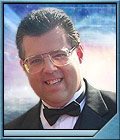 Bruce Woloshyn is the Digital Effects Supervisor and Lead
Digital Compositing Artist at Rainmaker Entertainment in Vancouver
and has worked on both Stargate SG-1 and Atlantis since the
begining of both shows. In this long interview he gave to
The Scifi World, he explained how much time him and his team
spent to model the city of Atlantis, what are the different
steps to create special effects, the details on The Lost City
and much more! He also explained how flattering it is to see
their work "replicated" by the fan's.
Bruce Woloshyn is the Digital Effects Supervisor and Lead
Digital Compositing Artist at Rainmaker Entertainment in Vancouver
and has worked on both Stargate SG-1 and Atlantis since the
begining of both shows. In this long interview he gave to
The Scifi World, he explained how much time him and his team
spent to model the city of Atlantis, what are the different
steps to create special effects, the details on The Lost City
and much more! He also explained how flattering it is to see
their work "replicated" by the fan's.
There's a big chance to see an Ori and a real ancient war
ship in the future ...
Discover 2 exclusive high resolution images of the Daedalus
offered by MGM and Bruce Woloshyn for The Scifi World. See
them at the bottom of the page!
Gilles Nuytens: You
are the Digital Effects Supervisor at Rainmaker, you delegate
work, provide direction to the artists, but do you do artwork/special
effects yourself?
Bruce Woloshyn: A great question.
And the simple answer is, "absolutely"! As a matter
of fact, up until the middle of last season (Stargate SG-1
season 8 and Stargate: Atlantis season 1), I held down the
position of Lead Digital Compositing Artist on both series
in addition to my supervisory capacity. And it is the Stargate
franchises, as an artist, that are one of my proudest professional
achievements.
Even now as a full-time supervisor, without my taking pen-to-tablet
as an artist everyday, I am still involved at the most detailed
level on every shot we produce. I actually still spend a considerable
amount of time with the individual artists on the show almost
every day. When I make my artist rounds, I can be doing everything
from planning initial shot composition and design with an
animator, to refining the shadow density on a final shot with
a compositor. The running joke right now for the digital compositors
on the show, is that when I sit down to discuss specific adjustments
to shots, I always start with, "Well, if it was me .
. . .", as I usually have very specific techniques in
mind about how to accomplish what I'd like to see.
Gilles Nuytens: How
did you become Digital Effects Supervisor? What is your professional
background?
Bruce Woloshyn: There are a couple
of key factors with the change in my title from Lead Digital
Compositing Artist to Digital Effects Supervisor. The first
is time. As I am now responsible for the day-to-day supervision
of the Rainmaker visual effects team for both of the Stargate
series, there simply isn't the time for me to spend the necessary
hours at a compositing workstation. My specific supervisory
responsibilities include everything from providing direction
and input to the artist team during shot development, to delegating
work priorities during any given day based on fluctuations
in schedules and individual shot progress. And, I not only
work with Rainmaker's visual effects team, but also with the
MGM Supervisors, visual effects and production teams. This
in itself has me traveling to the studio to attend principal
and second unit on-set photography both for supervision, and
to provide technical and design support. Finally, when it
comes right down to it, I am ultimately responsible for the
complete execution of Rainmaker’s visual effects for
both Stargate SG-1 and Stargate: Atlantis across all of our
company's divisions. Add that to my contributions to other
projects here at Rainmaker, and you can see why I had to make
the choice between being an artist and being a supervisor.
There simply are not enough hours in the day to do both jobs.
The second factor in my becoming a full time supervisor, is
that as my experience in all facets of visual effects grew,
it began to make more sense for us as a company to have me
supervise teams of artists on greater volumes of shots rather
than limit myself to only the shots that I could create as
a single artist. I must admit, that I did find this a difficult
adjustment at first (letting go of the pen was pretty hard),
but am now really starting to enjoy my new role.
As far as my professional background, I'm starting to feel
a little old whenever I'm asked this question (when, in fact,
I just started really young). I completed my scholastic broadcast
education in 1984 with an honors diploma in Radio and Television
Arts from the Northern Alberta Institute of Technology in
Edmonton. I then spent the next several years working as a
technical director for various broadcasters in Canada before
making the jump to full-time editing in 1989. As the world
of television editing began to enter the digital age, I found
myself becoming more immersed in what was then becoming digital
compositing.
In the spring of 1995 I was attending the NAB convention in
Las Vegas (www.nab.org/conventions)
and was introduced to a revolutionary new compositing system
called Flame, by Discreet
Logic. I can remember being floored with what this new
toolset could offer and even saying to my wife, "I'm
going to work for whoever will buy me one of these.".
As luck would have it, only a couple of months later I was
approached by Rainmaker founder, Bob Scarabelli, to move to
Vancouver and help start up what would become Rainmaker Animation
& Visual Effects (www.rainmaker.com).
The rest, as they say, is history.
For a complete list of my visual effects credits, check out
http://www.imdb.com/name/nm0004374.
Gilles Nuytens: You
certainly encountered some problems and big challenges during
the years you have been working on Stargate. Could you talk
about the most difficult project you had to do for Stargate?
And, at the same time, what are usually the most difficult
things to do in a project?
Bruce Woloshyn: The first question
is easy. No hesitation. The most difficult project I've ever
had is the pilot to Stargate: Atlantis, "Rising".
And the one thing that really differentiated the Atlantis
pilot from working on any other television series I've ever
done, was the shear amount of 3-D modeling that had to be
created up front. Every single model we needed, from the digital
props and set pieces, to the spacecraft and city itself, had
to be modeled from scratch. There would be no library of past
seasons to draw on for anything that we would need.
In addition to creating props and ships, we were also faced
with creating several digital set extensions and virtual environments.
The Puddle Jumper bay, masterfully created by Tom Brydon,
located in the central tower of the city is a good example.
The Puddle Jumper bay is basically a parking garage and maintenance
facility for up to twelve Puddle Jumpers (spacecraft), located
directly above the city’s main gate room. The starting
point for this was the practical set piece at the studio.
What was practically built represented the rear of one of
the six bays on the main floor of the two-story structure.
Texture photographs were taken of all of the on-set walls.
These photographs were later digitally painted into more variations
for the many more digital walls. While still at the studio,
we then trekked over to the main Gaterium set and in between
the live action takes we took additional photographs. These
would provide additional textures and act as reference for
the architectural style favored by the ancient builders of
Atlantis. This proved to be very important, as we constantly
strived to make the digital sets look like they belonged with
all of the live action sets. Lighting the bay was done with
200 lights of all types: shadow mapped spots, point lights
and area lights. To make rendering more efficient, some smaller
light sources were baked onto the actual textures. A few radiosity
test renders were done to get a feel for the look we were
after. This look was then reproduced using regular lighting
to, once again, keep our rendering times reasonable. To get
shots out fast, meant building only the sections visible in
the first shots then finishing off rest of the bay as time
permitted (as eventually in the series, we knew that the entire
bay would be required).
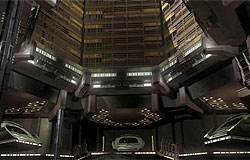 Where
I'm going with this, is that even with all of this work, the
Puddle Jumper bay was only one of the assets we would need
to create for the project. Which is what leads me to answer
the second question. One of the consistently difficult things
for me to do in a project is to manage the time and resources
to create all of the assets needed to complete all of the
shots. With more and more shots, on an increasingly more challenging
schedule, it takes a great deal of organization to be consistent
with the quality of work that our standards demand and still
deliver on time. Where
I'm going with this, is that even with all of this work, the
Puddle Jumper bay was only one of the assets we would need
to create for the project. Which is what leads me to answer
the second question. One of the consistently difficult things
for me to do in a project is to manage the time and resources
to create all of the assets needed to complete all of the
shots. With more and more shots, on an increasingly more challenging
schedule, it takes a great deal of organization to be consistent
with the quality of work that our standards demand and still
deliver on time.
Gilles
Nuytens: Now that season
10 of SG-1 and season 3 of Atlantis have officially been given
the go-ahead, do you already have some information about the
work you will have to do?
Bruce Woloshyn: I'm sorry to disappoint
you, but no. As we approach the end of visual effects production
for this season, I haven't had many opportunities to visit
with Brad Wright (executive producer) about what next year
will hold for either series.
Gilles Nuytens:
What do you think of fan 3D artworks
on Stargate, such as Mirko Stödter arts (see here for
example: (www.thescifiworld.net/wallpapers_stargate_mirkostoedter.htm)
or Ed Giddings arts (see here: www.stargate3d.fsnet.co.uk)
... or mine! (www.thescifiworld.net/wallpapers_stargate_gillesnuytens.htm)?
Bruce Woloshyn: There is a saying,
"imitation is the sincerest form of flattery". It
is only in the past couple of years that I have been really
exposed to the internet fan base for our shows and how much
fan art is really out there. I must admit, it has taken some
time to get used to the fact that there are people trying
to replicate the kind of things we do for both Stargate series.
And, as these examples show, some of the work is quite stunning.
As I said, it is very flattering.
Gilles
Nuytens: Could you describe
the details on how is it different to work on projects such
as "I, Robot" or "Elektra" and TV shows
such as Stargate?
Bruce Woloshyn: The biggest difference
between doing effects on a feature film and doing effects
on an episodic series, like the Stargate franchise, is the
schedule (and with that, the budget). Both of these factors
determine how much time there is to do . . . well, everything.
The schedule and the budget both affect the time. And time,
is either your best friend, or your worst enemy. In many cases,
the actual details of getting the visual effects completed
on a film or a television show (especially a television show
completed in high definition) are very similar. And when we
redesigned our production pipelines for both SG-1 and Atlantis
for full HDTV, they really didn't differ that much from the
pipelines we designed for our feature film work. As a matter
of fact, most parts of the technical pipeline are exactly
the same. The things that are different, are the way we manage
the resources to deal with the faster turnaround of shots,
and the fact that we need to be able to work on up to eight
separate episodes (over both series) at the same time. And
this, all comes back to the schedule.
Gilles
Nuytens: The Stargate SG-1
double episode "Lost City" is, in my opinion, one
of the best episodes of the series. We can see all kind of
visual effects, big battle scenes, spaceships, virtual locations
and other great visual effects (explosions, drones, etc ...).
How was it to work on this, is it all done by your team?
Bruce Woloshyn: The season 7 finale
of Stargate SG-1 was, at the time, touted as the biggest and
most ambitious set of visual effects episodes for the series
. . . ever (however, of course, we've now surpassed that several
times over). Not only in the volume of work, but in the complexity
of the visual effects shots. Nonetheless, season 7's effects
are impressive . . . an alien planet covered in lava; an aerial
battle over the Antarctic; a firefight beneath the ice; the
"freezing" of Colonel Jack O'Neill. The episode's
description sounds grand, but for our team, the visual effects
execution was all the more remarkable. These shots not only
sounded impressive to me, they sounded just plain cool. And
creating images that are "cool" has always been
something that drives our team.
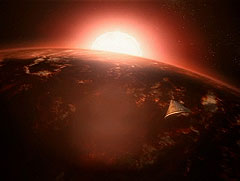 These
particular episodes had the work split up between our team
here at Rainmaker, Image Engine Design (www.image-engine.com)
and the now defunct, GVFX. In "Lost City Part 1",
both Rainmaker and Image Engine shared the effects workload
on the Death Glider Assault on SG-1 at the temple. While Rainmaker
completed the matte paintings and weapons fire when Anubis
has his Super Soldiers take out the Jaffa who disappointed
him on the planet. In "Lost City Part 2", Rainmaker
was responsible for creating the lava planet, the firefight
between the SG-1 team and the Super Soldiers in the outpost,
Anubis's face effects and the "freezing" of O'Neill
at the end of the show. Image Engine was responsible for creating
Antarctica and the amazing battle between the F-302 fighters
and Anubis's strike force, as well as the Prometheus and Anubis's
fleet in orbit. And GVFX created some additional transport
rings shots. These
particular episodes had the work split up between our team
here at Rainmaker, Image Engine Design (www.image-engine.com)
and the now defunct, GVFX. In "Lost City Part 1",
both Rainmaker and Image Engine shared the effects workload
on the Death Glider Assault on SG-1 at the temple. While Rainmaker
completed the matte paintings and weapons fire when Anubis
has his Super Soldiers take out the Jaffa who disappointed
him on the planet. In "Lost City Part 2", Rainmaker
was responsible for creating the lava planet, the firefight
between the SG-1 team and the Super Soldiers in the outpost,
Anubis's face effects and the "freezing" of O'Neill
at the end of the show. Image Engine was responsible for creating
Antarctica and the amazing battle between the F-302 fighters
and Anubis's strike force, as well as the Prometheus and Anubis's
fleet in orbit. And GVFX created some additional transport
rings shots.
I remember having great fun on this episode, but being under
the gun to complete "Lost City Part 2", as it was
the final episode of the season with so much work to be completed.
The shots in "Lost City Part 2" where SG-1 drops
out of hyperspace in the cargoship and flies toward the outpost
dome on the lava planet was one of favorite sequences from
season seven (created by lead 3D animator Wes Sargent and
myself).
Gilles Nuytens: How
much time did that take for your team to build the complete
Atlantis city model? Can you talk about that project? I also
think that the first project of the city was re-used in the
pilot as the ancient city on Athosia (or at least they looked
similar), is that true?
Bruce Woloshyn: Now here are some
impressive statistics. The centerpiece for the pilot’s
modeling was, of course, the exterior of the lost city itself.
We spent approximately 108 hours of design modeling and .
. . are you ready for this? . . . over 1,300 hours of modeling
and texturing on the main model. And, as the city model went
through many design iterations, by the time it was completed
it came in at around four million polygons and over a gigabyte
of textures. Because of it’s sheer size and the variety
of shots present in the pilot, it needed to look good from
all angles; hence it was an extremely complex model. In lighting
the city, we created a lighting rig with a combination of
directional and area lights that could be adapted to unique
situations, but which allowed us to keep consistency through
all of the shots. Not to mention, show off all the work that
had been done by the team on this monster model.
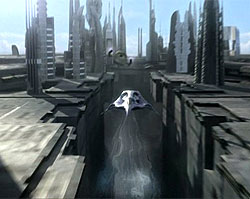 Although
the city of Atlantis was the most challenging of our hard-surface
models, even more daunting was the modeling of the surface
of the sea surrounding the city. We struggled at first whether
to go with Maya, because of it’s inherit water controls,
or LightWave, as that’s what we would be creating the
city and all of the master scene files with. In the end, we
ended up going with both. The main water surface was created
in LightWave and utilized the NatureFX plug-in from Dynamic
Realities to help finesse the look. We then used Maya for
the hundred of layers of particles and splash dynamic simulations.
And, of course, the entire city rising sequence really came
together as all of the incredible 3D animation was assembled
and enhanced by our compositing team lead by Debora Dunphy. Although
the city of Atlantis was the most challenging of our hard-surface
models, even more daunting was the modeling of the surface
of the sea surrounding the city. We struggled at first whether
to go with Maya, because of it’s inherit water controls,
or LightWave, as that’s what we would be creating the
city and all of the master scene files with. In the end, we
ended up going with both. The main water surface was created
in LightWave and utilized the NatureFX plug-in from Dynamic
Realities to help finesse the look. We then used Maya for
the hundred of layers of particles and splash dynamic simulations.
And, of course, the entire city rising sequence really came
together as all of the incredible 3D animation was assembled
and enhanced by our compositing team lead by Debora Dunphy.
As far as the two shots of the Athosian city, you're right.
The buildings were pulled from our "digital back lot"
of structures that we were creating for the city of Atlantis.
Gilles Nuytens: Now
a big question, can you describe the job of all the people
(or at least the most important ones) working for visual effects,
from the people working on the sets (green screens,...) to
the animators, modelers, ... ?
Bruce Woloshyn: Okay, here comes the
big answer . . . and I really mean it. Everyone is important
to work on the visual effects. I will list off some of the
jobs (using the pilot to Stargate: Atlantis as an example),
but everyone is important. From the producers and director,
whose visions we are in service of, to the entire production
crew. Unless the shot is entirely digitally created (and there
are a few of those in the pilot), everyone contributes to
the completed shot. The question of "can I describe the
job of all the people" would have you reading my response
for days (and believe me, we have actually written the job
descriptions for everyone).
I can, however, give you an example of one of the jobs that
keeps the entire operation running smoothly (which is no small
feat). The Visual Effects Co-ordinator (in the case of the
Stargate: Atlantis pilot, the three of them), is the position
closest to the supervisors for overseeing all of the work.
Here is a list of some of the things that a Visual Effects
Co-ordinator at Rainmaker is responsible for on Stargate SG-1
and Stargate: Atlantis:
- To create budget breakdowns in preparation for estimates.
- To attend production and VFX meetings.
- To oversee the maintenance of all schedules, crew lists
and call sheets, both internal and from production office.
- To keep the Digital Effects Supervisor informed of
set calls and schedule changes.
- On-set and in-suite assistance.
- To book sessions for CG, compositing and rotoscope
through the VFX Operations Supervisor.
- To act as a central contact for correspondence with
assistant editors for project specific information.
- To review the various cuts and EDL’s from MGM
and watch for any anomalies that may exist. These are
then to be communicated to the Digital Effects Supervisor
and VFX Producer.
- The ordering and administration of source plates and
VFX elements as per the Visual Effects Supervisors and/or
Digital Effects Supervisor.
- The assisting with the supervision of sessions.
- To organize VFX meetings and screenings.
- The recording of client notes and approvals.
- The maintaining and monitoring of each episode’s
project status.
- To work with the Lead Technical Operations Artist to
administrate all delivery outputs and dubbing.
And that's only a partial list. But it gives you an idea
of just how much there is to do, besides the actual shooting,
animating and compositing of shots. I am extremely fortunate
to have an amazing Visual Effects Co-ordinator, by the name
of Tara Conley, who looks after all of this (and more) for
me on a daily basis. But, as I said (and I really do mean
it), everyone is important. To that end, here is the complete
visual effects crew list for the pilot to Stargate: Atlantis,
"Rising":
Brad Wright Executive
Producer
Robert C. Cooper Executive
Producer
Martin Wood Director
Bob Scarabelli Rainmaker
Visual Effects Executive Producer
Michelle Comens Visual
Effects Producer
John Gajdecki Visual
Effects Supervisor
Bruce G. Woloshyn Digital
Effects Supervisor / Lead Digital Compositing Artist
Jinnie Pak Visual
Effects Co-ordinator
Tara Conley Visual
Effects Co-ordinator
James Rorick Visual
Effects Co-ordinator
Janice Groom Visual
Effects Operations Supervisor
Dan Mayer Lead
3D Animator
Wes Sargent Lead
3D Animator
Rod Bland 3D Animator
Jose Burgos 3D Animator
Nicholas Boughen 3D
Animator
Tom Brydon 3D Animator
Craig Calvert 3D
Animator
Ho Sung Cheon 3D
Animator
Bryan Davies 3D
Animator
Tristam Gieni 3D
Animator
Trevor Harder 3D
Modeler
Sean King 3D Animator
Megan Majewski 3D
Animator
Krista McLean 3D
Animator
Daniel Osaki 3D
Animator
Mark Pullyblank 3D
Animator
Les Quinn 3D Animator
Vishal Anand 3D
Animator
Debora Dunphy Lead
Digital Compositing Artist
Gary Poole Lead
Technical Operations Artist
Simon Ager Digital
Compositing Artist
Jordan Benwick Digital
Compositing Artist
Kristy Dearholt Digital
Compositing Artist
Chris Doll Digital
Compositing Artist
Keegan Douglas Digital
Compositing Artist
Peter Hunt Digital
Compositing Artist
Mathew Krentz Digital
Compositing Artist
Colin Liggett Digital
Compositing Artist
Tannis Mathers Digital
Compositing Artist
Christine Petrov Digital
Compositing Artist
Lee Pierce Digital
Compositing Artist
Carmen Pollard Digital
Compositing Artist
Trevor Strand Digital
Compositing Artist
Chris Wren Concept
Artist
Tracey Baxter Rotoscope
Artist
Madhava Reddy Rotoscope
Artist
Arnold Yuki Rotoscope
Artist
Hamish Hamilton Visual
Effects Assistant
Ken Hayward Director
of Technical Development
Ronald Knol VFX
& IT Engineering Supervisor
Zane Harker Resource
Manager
Joe De Michelis Information
Systems Administrator
Chi Pham VFX Systems
Administrator
Grant Bowen Applications
Support Specialist
Gilles Nuytens: What
are your most useful tools on-set and why?
Bruce Woloshyn: I'm going to answer
this question twofold. As the most useful tools on-set and
the most useful tools in completing a visual effects shot
for the series are not necessarily the same thing.
My most useful tool onset is, without a doubt, my measuring
tape (both the old fashion kind and my laser-measure). Besides
planning out what you have to do, and the order you have
to do it, the most important thing you can do on-set is
record useful and accurate data to bring back to the facility
to show the digital team what was happening during the photography
of the plates. A digital camera (for reference and textures)
is also right up there on my most useful tools list.
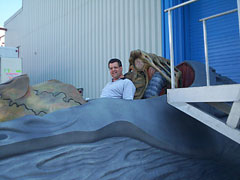 |
|
My most useful tool back at the facility is previs (although
this is not necessarily always the case). When it comes
to producing visual effects for a television series, the
efficiency of shot-by-shot execution is always at the forefront
of my planning. To this end, I am utilizing previsualization
to a much greater extent than ever before. In many cases,
especially for Stargate: Atlantis, many of our final shots
match second-for-second to the previs that was created at
the planning stage. This production model not only helps
to lock a significant amount of visual effects shots in
a particular scene, but sometimes even before we go to camera.
Completing previs prior to going to camera, then allows
us to further refine our elements list so we knew exactly
what we are shooting on the day.
There is no better example of this process than the climactic
space battle in the pilot of Stargate: Atlantis. The sequence
consisted of over 30 shots, all of which had only brief
descriptions of the action in the script. In order to better
work with the producers and director in choreographing the
battle, we set up an on-site animation station. This physical
proximity to production allowed us to be able to receive
quick feedback and implement changes much faster. Since
the shots were prevised in LightWave, it allowed us to come
back to Rainmaker and substitute the previs models with
the high-resolution ships that were being built, while the
animation was still being created. Animation and camera
movement could be approved with the low-resolution models
and then sent back to have the real ships substituted in
their place. This provided a seamless integration from previs
to final renders that allowed us to get the high volume
of shots in a very short timeframe.
Gilles Nuytens: What
advice could you give to visual effects students or beginners?
Bruce Woloshyn: This is actually
a very hard question to answer, as there are just so many
different jobs in the visual effects field and I would offer
different advise for almost every one. The best advise I
was ever given, was from my Father. He said, “Pick
something you really like to do, and be really good at it.”
I have been incredibly lucky, in always knowing what I wanted
to do. This hasn’t come without sacrifice and a lot
of hard work. The best advice I would offer to anyone interested
in getting into visual effects is this . . . . be really
sure this is what you want to do. This industry requires
a lot from you, both in dedication and time. To excel, you
have to be ready to give both.
Gilles Nuytens: I'd
be interested to see a "real" ancient war ship
fully operational and Ori ships, is there something that
goes this way in the future?
Bruce Woloshyn: We are currently
working on the season finales of both series right now (Stargate
SG-1 season 9 and Stargate: Atlantis season 2). Look to
the future, as you may get what you wish for. Although I'd
love to give everyone a sneak-peek at what we have in store
for the rest of the season, I'm afraid you'll have to wait
for both Stargate SG-1 and Stargate: Atlantis to resume
airing in January on SCI-FI.
Stargate:
Atlantis "The Siege Part 3"
- VFX Scene 067x02 |
|
|
Executive Producers:
Brad Wright
Robert C. Cooper
Director: Martin
Wood
Visual Effects Supervisor:
James Tichenor
Digital Effects Supervisor:
Bruce G. Woloshyn
Visual Effects Co-ordinator:
Tara Conley
3D Animators:
Wes Sargent
Rod Bland
Digital Compositing Artist:
Simon Ager
|
| Stargate: Atlantis
"Trinity" - VFX Scene 083x01 |
|
|
Executive Producers:
Brad Wright
Robert C. Cooper
Director: Martin
Wood
Visual Effects Supervisor:
Mark Savela
Digital Effects Supervisor:
Bruce G. Woloshyn
Visual Effects Co-ordinator:
Tara Conley
3D Animators:
Wes Sargent
Rod Bland
Tom Brydon
Dan Mayer
Digital Compositing Artist:
Simon Ager
|
|